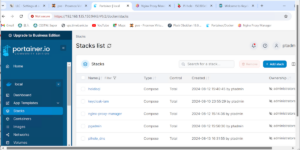主題: Portainer/Docker 容器中的多個堆疊如何與全球和台灣 CES 的應用程式和網路協作,以強化「社群是最好良藥」方法
By Daniel Chen, co-working with ChatGPT
 前言: 從2024年7月起,台灣「社益網」為因應全球「社益網」(Community Exchange System, CES)共同協作,進一步提升資通科技創新力,特別與ChatGPT協作,建置與交付以下 Docker Multiple Stacks 的系統整合應用。期能夠進一步強化「社區/社群集群」(Community Cluster)的「共同生產力」(Co-Productivity, more than just Co-Production only)。
前言: 從2024年7月起,台灣「社益網」為因應全球「社益網」(Community Exchange System, CES)共同協作,進一步提升資通科技創新力,特別與ChatGPT協作,建置與交付以下 Docker Multiple Stacks 的系統整合應用。期能夠進一步強化「社區/社群集群」(Community Cluster)的「共同生產力」(Co-Productivity, more than just Co-Production only)。
Google Doc: https://docs.google.com/document/d/1uGL4R9zMqs45bk8ro-4pIirmivA-N5XadVat3SJ1P_0/edit?usp=sharing
| How Multiple Stacks in Portainer/Docker Containers Can Co-Work with Global and Taiwan CES’ Apps and Networks to Strengthen the “Community is the Best Medicine” Approach
### Introduction The “Community is the Best Medicine” approach highlights the importance of community-driven initiatives in fostering health, well-being, and resilience. The Community Exchange System (CES) offers a platform that supports local economies, time banking, and social networks, which align with this approach. By integrating Docker containers managed via Portainer with CES applications and networks, communities can enhance their capacity to achieve Sustainable Development Goals (SDGs) within the World Development Within Planetary Boundaries (WDWPB) framework. This document explores how multiple Docker stacks can synergize with Global and Taiwan CES platforms to promote sustainable and resilient communities. ### Docker Stacks in Portainer: A Foundation for Community Empowerment Docker containers, managed via Portainer, provide a scalable and flexible infrastructure for deploying community-focused applications. The following stacks, as illustrated in the provided image, form the core of this infrastructure: – **HeidiSQL** – **Keycloak-IAM** – **Nginx Proxy Manager** – **pgAdmin** – **Pi-hole DNS** These stacks play distinct yet complementary roles in managing community resources, securing user data, and facilitating communication across platforms. When integrated with CES applications, they enable a robust, community-driven platform that supports the “Community is the Best Medicine” approach. ### Co-Working with Global and Taiwan CES’ Apps and Networks
– **Role:** HeidiSQL, as an SQL client, allows for efficient management and querying of databases. This is crucial for CES, where accurate and up-to-date data on user transactions, timebank exchanges, and community resources are vital. – **Integration:** By linking HeidiSQL with CES databases, communities can gain insights into local economies, track the flow of social capital, and ensure transparency in exchanges. This promotes trust within the community and encourages broader participation.
– **Role:** Keycloak provides identity and access management (IAM) services, ensuring secure and streamlined authentication across CES platforms. – **Integration:** Keycloak can be integrated with both Global and Taiwan CES networks to manage user identities, control access to sensitive data, and facilitate single sign-on (SSO). This ensures that users can seamlessly access CES services while protecting their privacy and security, fostering a safe and inclusive community environment.
– **Role:** Nginx Proxy Manager simplifies the management of reverse proxies, SSL certificates, and domain-based routing, ensuring secure and efficient handling of network traffic. – **Integration:** In the context of CES, Nginx Proxy Manager can be used to route traffic between different CES applications and services, ensuring that users experience minimal downtime and high availability. This is especially important for time-sensitive exchanges and communication within the community.
– **Role:** pgAdmin, as a management tool for PostgreSQL, offers comprehensive database administration and development capabilities. – **Integration:** pgAdmin can manage CES-related data stored in PostgreSQL databases, ensuring data integrity and availability. This is crucial for maintaining a reliable record of transactions, user interactions, and resource allocation within the CES platform, thereby supporting community resilience and sustainability.
– **Role:** Pi-hole acts as a network-wide ad blocker and DNS sinkhole, protecting users from intrusive ads and malicious content. – **Integration:** Pi-hole can be deployed within the CES network to ensure a clean and secure browsing experience for users. By blocking unwanted content, Pi-hole helps maintain focus on community-driven activities and prevents the distraction of ads, enhancing the user experience. ### Achieving SDG Goals through CES Integration The integration of these Docker stacks with CES applications and networks directly contributes to the achievement of several SDGs, particularly within the WDWPB framework: – **SDG 1: No Poverty**: By facilitating local economies and time banking through CES, communities can reduce poverty by enabling resource sharing and mutual support. – **SDG 3: Good Health and Well-being**: The “Community is the Best Medicine” approach, supported by CES, promotes social interaction and mutual care, which are essential for mental and physical well-being. – **SDG 11: Sustainable Cities and Communities**: CES, enhanced by Docker stacks, supports the development of sustainable and resilient communities by enabling local governance, resource management, and social cohesion. – **SDG 10: Reduced Inequalities**: By providing equitable access to CES platforms, these Docker stacks help reduce social and economic inequalities, ensuring that all community members can participate and benefit. ### Conclusion The combination of Docker stacks managed via Portainer with CES applications and networks offers a powerful toolset for fostering community resilience and well-being. By integrating these technologies, communities can effectively implement the “Community is the Best Medicine” approach, achieving key SDG goals within the WDWPB framework. This synergy not only strengthens local economies and social networks but also ensures that communities remain sustainable, inclusive, and resilient in the face of global challenges. |
《 Portainer/Docker 容器中的多個堆疊如何與全球和台灣 CES 的應用程式和網路協作,以強化「社群是最好良藥」方法》
### 介紹 這 「社區是最好良藥」方法強調以社區驅動為本的措施來促進健康、福祉和復原力方面的重要性。中文名稱「社益網」 社區交流系統 (Community Exchange System, CES)提供了一個支持當地經濟、時間銀行和社交網路的平台,這與這種方法一致。透過將 Portainer 管理的 Docker 容器與 CES 應用程式和網路整合,社群可以增強其實現永續發展目標 (SDG) 的能力 地球邊界內的世界發展(WDWPB)框架。本文檔探討了多個 Docker 堆疊如何與全球和台灣 CES 平台協同作用,以促進永續和有彈性的社群。 ### Portainer 中的 Docker Stacks:社群賦權的基礎 透過 Portainer 管理的 Docker 容器為部署以社群為中心的應用程式提供了可擴展且靈活的基礎架構。如所提供的圖像所示,以下堆疊構成了該基礎設施的核心: – **HeidiSQL** – **Keycloak-IAM** – **Nginx Proxy Manager** – **pgAdmin** – **Pi-hole DNS** 這些堆疊在管理社群資源、保護用戶資料和促進跨平台通訊方面發揮著獨特但互補的作用。當與 CES 應用程式整合時,它們可實現強大的社群驅動平台,支援「社群是最好藥物」方法。 ### 與全球和台灣 CES 的應用程式和網路合作
– **角色:** HeidiSQL作為SQL客戶端,可以對資料庫進行高效率的管理與查詢。這對 CES 至關重要,因為用戶交易、時間銀行交換和社群資源的準確和最新數據至關重要。 – **整合:** 透過將 HeidiSQL 與 CES 資料庫連接,社群可以深入了解當地經濟,追蹤社會資本流動,並確保交換的透明度。這促進了社區內的信任並鼓勵更廣泛的參與。
– **角色:** Keycloak 提供身分和存取管理 (IAM) 服務,確保跨 CES 平台安全且簡化的身份驗證。 – **整合:** Keycloak 可以與全球和台灣 CES 網路整合,以管理使用者身分、控制對敏感資料的存取並促進單一登入 (SSO)。這確保了用戶可以無縫存取CES服務,同時保護他們的隱私和安全,創造一個安全和包容的社區環境。
– **角色:** Nginx 代理程式管理員簡化了反向代理、SSL 憑證和基於網域的路由的管理,確保安全且有效率地處理網路流量。 – **整合:** 在 CES 背景下,Nginx 代理程式管理員可用於在不同 CES 應用程式和服務之間路由流量,確保使用者體驗最短的停機時間和高可用性。這對於社區內時間敏感的交流和溝通尤其重要。
– **角色:** pgAdmin作為PostgreSQL的管理工具,提供全面的資料庫管理和開發功能。 – **整合:** pgAdmin可以管理儲存在PostgreSQL資料庫中的CES相關數據,確保資料的完整性和可用性。這對於維護 CES 平台內交易、用戶互動和資源分配的可靠記錄至關重要,從而支持社群的彈性和永續性。
– **角色:** Pi-hole 充當網路範圍內的廣告攔截器和 DNS 污水坑,保護使用者免受侵入性廣告和惡意內容的侵害。 – **整合:** Pi-hole 可以部署在 CES 網路內,以確保使用者獲得乾淨、安全的瀏覽體驗。透過阻止不必要的內容,Pi-hole 有助於保持對社群驅動的活動的關注,並防止廣告分散注意力,從而增強用戶體驗。 ### 透過 CES 整合實現永續發展目標 這些 Docker 堆疊與 CES 應用程式和網路的整合直接有助於實現多個 SDG,特別是在 WDWPB 框架內: – **永續發展目標 1:消除貧窮**: 透過 CES 促進當地經濟和時間銀行,社區可以透過實現資源共享和相互支持來減少貧困。 – **永續發展目標 3:良好的健康與福祉**: CES 支持的「社區是最好的良藥」方法促進社會互動和相互關懷,這對於身心健康至關重要。 – **永續發展目標 11:永續城市與社區**: CES 由 Docker 堆疊增強,透過實現地方治理、資源管理和社會凝聚力來支持可持續和有彈性的社區的發展。 – **永續發展目標 10:減少不平等**: 透過提供對 CES 平台的公平訪問,這些 Docker 堆疊有助於減少社會和經濟不平等,確保所有社區成員都能參與並受益。 ### 結論 透過 Portainer 管理的 Docker 堆疊與 CES 應用程式和網路結合,提供了強大的工具集,可增強社群的彈性和福祉。透過整合這些技術,社區可以有效實施「社區是最好的藥物」的方法,在 WDWPB 框架內實現關鍵的永續發展目標。這種協同作用不僅加強了當地經濟和社會網絡,還確保社區在面對全球挑戰時保持永續、包容性和彈性。 |
